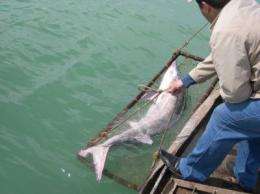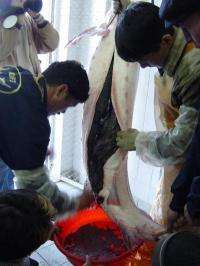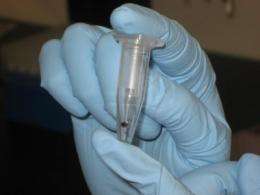International regulation curbs illegal trade of caviar

Research that used mitochondrial DNA-based testing to compare the extent of fraudulent labeling of black caviar purchased before and after international protection shows conservation benefits. A team of scientists from the Institute for Conservation Science at Stony Brook University and the Sackler Institute for Comparative Genomics at the American Museum of Natural History (AMNH) repeated a market survey of commercially available caviar in the New York City area that was conducted before the protection was put in place, and the results showed nearly a 50 percent decrease in fraudulently labeled caviar.
"Testing the effectiveness of an international conservation agreement: marketplace forensics and CITES caviar trade regulation," published online on July 25 in the journal PLoS ONE, compared the results of two market surveys conducted 10 years apart. The previous market survey conducted during 1995 through 1996, before the listing of the sturgeon by the Convention on International Trade in Endangered Species (CITES) came into effect in 1998, revealed that 19 percent of commercially available caviar in the New York City area was mislabeled with respect to species origin. When sampling the same market from 2006 through 2008, fraudulently labeled caviar occurred in 10 percent of the caviar, and only occurred in the samples bought online.

"The results of our analysis suggest that the international trade regulation of sturgeon products due to the Convention on International Trade in Endangered Species listing is having a positive effect in the marketplace," said Dr. Phaedra Doukakis, lead author, who was a senior research scientist with the Institute for Ocean Conservation Science at Stony Brook University at the time the study was conducted. "CITES is clearly an important tool for regulating trade and serves as an important complement to management in the regions where fishing occurs. More marine and aquatic species could benefit from being listed under the Convention."
Sturgeons and paddlefishes (Order Acipenseriformes), the producers of black caviar, are protected by CITES due to widespread population abundance declines from overfishing, habitat degradation, and illegal trade in caviar. Intentional mislabeling of caviar products can thwart trade regulations and diminish their impact on the conservation of the sturgeon. The conservation status of many sturgeon species has not improved, and has worsened in several cases, since the CITES listing, with most species now listed as "Critically Endangered" by the International Union for Conservation of Nature (IUCN) because overfishing remains a problem.

"It's encouraging that the extent of illegal trade has diminished in recent years since international trade restrictions have come into force. Consumers can now be highly confident that what's written on the label accurately describes what's in the tin," said Dr. Ellen K. Pikitch, co-author and executive director of the Institute for Ocean Conservation Science and professor at Stony Brook University. "However, preventing the extinction of critically endangered species such as the beluga sturgeon requires a full court press. Importantly, smaller fishing allowances, including bans on fishing in key geographic areas and better enforcement of fishing regulations, are needed to give depleted sturgeon populations a fighting chance to recover."
In addition to demonstrating the conservation benefits of trade regulation for threatened and endangered species, the research results also underscore the utility of such testing for enforcement of these regulations.
"The results of this study demonstrate the effectiveness of DNA-based methods to identify the species of origin for detection of illegal products in the marketplace," said George Amato, co-author and director of the Sackler Institute for Comparative Genomics at the American Museum of Natural History. "Moreover, these results demonstrate if this type of genetic testing is used by inspection officials in real time, it can help detect and discourage illegal harvesting of threatened and endangered marine species in the geographic regions in which it is occurring."
More information: "Testing the effectiveness of an international conservation agreement: marketplace forensics and CITES caviar trade regulation," dx.plos.org/10.1371/journal.pone.0040907
Journal information: PLoS ONE
Provided by The Institute for Ocean Conservation Science
















